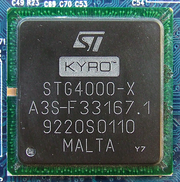ST Kyro
The ST-Kyro series from STMicroelectronics is a family of 3D graphics chips for AGP based on the IP of the PowerVR Series 3 and is therefore a tilebased deferred renderer (TBDR). Another representative based on the PowerVR Series 4 was planned and almost completed, but STMicroelectronics decided to exit the graphics business and closed the corresponding department. The Series 3 was later optimized for mobile devices and was a success as the PowerVR MBX .
Versions
ST Kyro
In June 2000, STMicroelectronics, a new licensee for the PowerVR Series 3 was announced and the first chip, Kyro (also known as Kyro 128 ), was launched in autumn 2000. As a low-cost product, the chip was positioned against Nvidia's GeForce 2 MX and was able to convince with better features.
ST Kyro II
In April 2001, STMicroelectronics then added the Kyro II , which only added a longer pipeline and more modern production to achieve higher clock rates and was otherwise identical to the Kyro. But since the clock rate was increased by a remarkable 50% - which the chip can convert almost 1: 1 into more power - the performance was very convincing. Kyro II became an unexpected sales success. Officially, like the Kyro I, it was supposed to compete against the GeForce 2 MX, but in practice it could compete with a GeForce 2 GTS and even outperform it in some cases. Like its predecessor, Kyro II cards were AGP 2.0 models. Due to an internal problem, the standard AGP-4x mode in the Kyro II was deactivated compared to its predecessor. Although it proved to be AGP 2.0 capable, some pure AGP 2.0 mainboards refused to operate with the card because of this deactivated function, since they assumed an incorrectly coded AGP 1.0 model, which they do not support.
ST Kyro II SE
A short time later there were rumors about another refresh chip, the Kyro II SE , which was actually presented at CeBit 2002 , but never actually delivered because STMicroelectronics decided to exit the graphics business. In addition to a higher clock rate, it should be able to pass through its enT & L, enhanced T&L, to enable newer games to run without patches. However, since this only meant redirecting corresponding commands to the CPU, this did not correspond to a hardware improvement. The enT&L capability was also submitted with driver version 2.0 for previously released Kyro cards. For Kyro II models, it was also possible to synchronize with the level of the SE variant using a driver's own slider.
ST Kyro III
Actually, the PowerVR Series 4 a. k. a. Kyro III will also be presented at CeBit 2002, but that never happened. STMicroelectronics and PowerVR tried to sell the graphics division (as well as the licenses for PowerVR Series 4 and PowerVR Series 5), among others VIA Technologies was interested , but no deal came off.
Model data
| Model | year | Code name | Manufacturing process ( nm ) | Transistors (in millions) | interface | Max. Memory ( MB ) | Clock (Chip) (MHz) | Clock (memory) (MHz) | Pipes x TMUs x VPUs | Fill rate ( MT / s) | Memory bandwidth ( GB / s) | Memory bus type | Memory bus width ( bit ) | DirectX version | OpenGL version | Features |
|---|---|---|---|---|---|---|---|---|---|---|---|---|---|---|---|---|
| ST Kyro | 2000 | STG-4000 | 250 | 12 | AGP , PCI | 64 | 115 | 115 | 2 × 1 | 230 | 1.8 | SDRAM | 128 | 6th | 1.4 | TBDR , S3TC, FSAA |
| ST Kyro II | 2001 | STG-4500 | 180 | 15th | AGP | 64 | 175 | 175 | 2 × 1 | 350 | 2.8 | SDRAM | 128 | 6th | 1.4 | TBDR , S3TC, FSAA |
| ST Kyro II SE | 2002 | STG-4800 | 180 | 15th | AGP | 64 | 200 | 200 | 2 × 1 | 400 | 3.2 | SDRAM | 128 | 6th | 1.4 | TBDR , S3TC, FSAA |
| ST Kyro III | STG-5500 | 130 | ? | AGP | 64 | ~ 250 | ? | 4 × 1 | ? | ? | DDR SDRAM | 128 | 7 or 8 | 1.4 | TBDR , S3TC, FSAA, Hardware T&L |
See also
Web links
Dees RegFix Collection of optimal Kyro driver settings for many 3D applications


